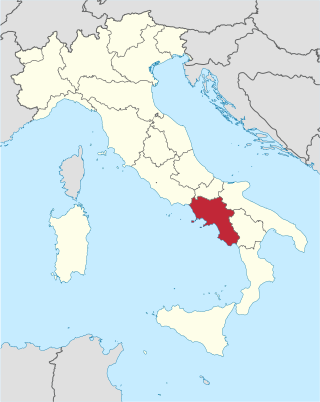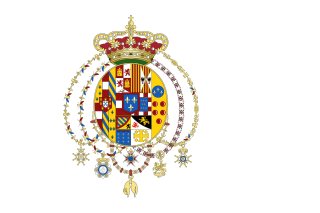
Alfonso the Magnanimous was King of Aragon and King of Sicily and the ruler of the Crown of Aragon from 1416 and King of Naples from 1442 until his death. He was involved with struggles to the throne of the Kingdom of Naples with Louis III of Anjou, Joanna II of Naples and their supporters, but ultimately failed and lost Naples in 1424. He recaptured it in 1442 and was crowned king of Naples. He had good relations with his vassal, Stjepan Kosača, and his ally, Skanderbeg, providing assistance in their struggles in the Balkans. He led diplomatic contacts with the Ethiopian Empire and was a prominent political figure of the early Renaissance, being a supporter of literature as well as commissioning several constructions for the Castel Nuovo.

Campania is an administrative region of Italy; most of it is in the south-western portion of the Italian peninsula, but it also includes the small Phlegraean Islands and the island of Capri. The capital of the Campania region is Naples. As of 2018, the region had a population of around 5,820,000 people, making it Italy's third most populous region, and, with an area of 13,590 km2 (5,247 sq mi), its most densely populated region. Based on its GDP, Campania is also the most economically productive region in southern Italy and the 7th most productive in the whole country. Naples' urban area, which is in Campania, is the eighth most populous in the European Union. The region is home to 10 of the 58 UNESCO sites in Italy, including Pompeii and Herculaneum, the Royal Palace of Caserta, the Amalfi Coast and the Historic Centre of Naples. In addition, Campania's Mount Vesuvius is part of the UNESCO World Network of Biosphere Reserves.

Naples is the regional capital of Campania and the third-largest city of Italy, after Rome and Milan, with a population of 909,048 within the city's administrative limits as of 2022. Its province-level municipality is the third-most populous metropolitan city in Italy with a population of 3,115,320 residents, and its metropolitan area stretches beyond the boundaries of the city wall for approximately 30 kilometres.

Joseph-Napoléon Bonaparte was a French statesman, lawyer, diplomat and older brother of Napoleon Bonaparte. During the Napoleonic Wars, the latter made him King of Naples (1806–1808), and then King of Spain (1808–1813). After the fall of Napoleon, Joseph styled himself Comte de Survilliers and emigrated to the United States, where he settled near Bordentown, New Jersey, on an estate overlooking the Delaware River not far from Philadelphia.

Naples is a city in Collier County, Florida, United States. As of the 2020 census, the population was 19,115. Naples is a principal city of the Naples–Marco Island metropolitan area, which had a population of about 375,752 as of 2020. Naples' USPS City population includes most of the communities in Collier County with the notable exceptions of Immokalee, Marco Island, Ave Maria, Everglades City and a few others, and thus Naples' USPS City population is approximately 333,083.

Charles III was King of Spain in the years 1759 to 1788. He was also Duke of Parma and Piacenza, as Charles I (1731–1735); King of Naples, as Charles VII; and King of Sicily, as Charles III (1735–1759). He was the fourth son of Philip V of Spain and the eldest son of Philip's second wife, Elisabeth Farnese. He was a proponent of enlightened absolutism and regalism.

Ferdinand I was King of the Two Sicilies from 1816 until his death. Before that he had been, since 1759, King of Naples as Ferdinand IV and King of Sicily as Ferdinand III. He was deposed twice from the throne of Naples: once by the revolutionary Parthenopean Republic for six months in 1799, and again by a French invasion in 1806, before being restored in 1815 at the end of the Napoleonic Wars.

The Kingdom of Naples, also known as the Kingdom of Sicily, was a state that ruled the part of the Italian Peninsula south of the Papal States between 1282 and 1816. It was established by the War of the Sicilian Vespers (1282–1302), when the island of Sicily revolted and was conquered by the Crown of Aragon, becoming a separate kingdom also called the Kingdom of Sicily. This left the Neapolitan mainland under the possession of Charles of Anjou. Later, two competing lines of the Angevin family competed for the Kingdom of Naples in the late 14th century, which resulted in the death of Joanna I by Charles III of Naples. Charles' daughter Joanna II adopted King Alfonso V of Aragon as heir, who would then unite Naples into his Aragonese dominions in 1442.

The Kingdom of Sicily was a state that existed in the south of the Italian Peninsula and, for a time, in the region of Ifriqiya from its founding by Roger II of Sicily in 1130 until 1816. It was a successor state of the County of Sicily, which had been founded in 1071 during the Norman conquest of the southern peninsula. The island was divided into three regions: Val di Mazara, Val Demone and Val di Noto.

Neapolitan is a Romance language of the Italo-Romance group spoken in Naples and most of continental Southern Italy. It is named after the Kingdom of Naples, which once covered most of the area, since the city of Naples was its capital. On 14 October 2008, a law by the Region of Campania stated that Neapolitan was to be protected.

The Gulf of Naples, also called the Bay of Naples, is a roughly 15-kilometer-wide (9.3 mi) gulf located along the south-western coast of Italy. It opens to the west into the Mediterranean Sea. It is bordered on the north by the cities of Naples and Pozzuoli, on the east by Mount Vesuvius, and on the south by the Sorrento Peninsula and the main town of the peninsula, Sorrento. The Peninsula separates the Gulf of Naples from the Gulf of Salerno, which includes the Amalfi Coast.

Società Sportiva Calcio Napoli, commonly referred to as Napoli, is an Italian professional football club based in the city of Naples that plays in Serie A, the top flight of Italian football. They are the reigning champions in Italy, having won the Serie A titles in the 2022–23 season. In its history, Napoli has won three Serie A titles, six Coppa Italia titles, two Supercoppa Italiana titles, and one UEFA Cup.

Maria Carolina was Queen of Naples and Sicily as the wife of King Ferdinand IV and III, who later became King of the Two Sicilies. As de facto ruler of her husband's kingdoms, Maria Carolina oversaw the promulgation of many reforms, including the revocation of the ban on Freemasonry, the enlargement of the navy under her favorite, Sir John Acton, and the expulsion of Spanish influence. She was a proponent of enlightened absolutism until the advent of the French Revolution, when, in order to prevent its ideas gaining currency, she made Naples a police state.

Stadio Diego Armando Maradona, formerly known as Stadio San Paolo, is a stadium in the western Fuorigrotta suburb of Naples, Italy. It is the fourth largest football stadium in Italy, after Milan's San Siro, Rome's Stadio Olimpico and Bari's San Nicola. For the 1960 Summer Olympics in Rome, the stadium hosted the football preliminaries. It is currently used mostly for football matches and is the home stadium of S.S.C. Napoli. Constructed in 1959, the stadium was extensively renovated in 1989 for the 1990 World Cup and again in 2018. The stadium currently accommodates 60,240 spectators, but in the past with terraced sections, the stadium took close to 90,000.

Naples-Capodichino International Airport is the international airport serving Naples and the Southern Italian region of Campania. According to 2022 data, the airport is the fourth-busiest airport in Italy and the busiest in Southern Italy. The airport serves as a base for easyJet, Ryanair, Volotea and Wizzair. Located 3.2 NM north-northeast of the city in the Naples, the airport is officially named Aeroporto di Napoli-Capodichino Ugo Niutta, after decorated WWI pilot Ugo Niutta. The airport covers 233 hectares of land and contains one runway.

The Capetian House of Anjou, or House of Anjou-Sicily, or House of Anjou-Naples was a royal house and cadet branch of the Capetian dynasty. It is one of three separate royal houses referred to as Angevin, meaning "from Anjou" in France. Founded by Charles I of Anjou, the youngest son of Louis VIII of France, the Capetian king first ruled the Kingdom of Sicily during the 13th century. The War of the Sicilian Vespers later forced him out of the island of Sicily, which left him with the southern half of the Italian Peninsula, the Kingdom of Naples. The house and its various branches would go on to influence much of the history of Southern and Central Europe during the Middle Ages until it became extinct in 1435.
Patricia of Naples is an Italian virgin and saint. Tradition states that she was noble; she may have been related to the Roman Emperor. Some sources say that she was a descendant of Constantine the Great. The particulars traditional about her are unreliable and in some instances contradictory.
The Naples Daily News is the main daily newspaper of Naples, Florida, and Collier County. It is owned by Gannett.

The Kingdom of the Two Sicilies was a kingdom in Southern Italy from 1816 to 1861 under the control of a cadet branch of the Spanish Bourbons. The kingdom was the largest sovereign state by population and size in Italy before Italian unification, comprising Sicily and most of the area of today's Mezzogiorno in covering all of the Italian Peninsula south of the Papal States.

















